Ventricle WGCNA
Last updated: 2019-10-28
Checks: 5 2
Knit directory: fgf_alldata/
This reproducible R Markdown analysis was created with workflowr (version 1.4.0). The Checks tab describes the reproducibility checks that were applied when the results were created. The Past versions tab lists the development history.
The R Markdown file has unstaged changes. To know which version of the R Markdown file created these results, you’ll want to first commit it to the Git repo. If you’re still working on the analysis, you can ignore this warning. When you’re finished, you can run wflow_publish to commit the R Markdown file and build the HTML.
The global environment had objects present when the code in the R Markdown file was run. These objects can affect the analysis in your R Markdown file in unknown ways. For reproduciblity it’s best to always run the code in an empty environment. Use wflow_publish or wflow_build to ensure that the code is always run in an empty environment.
The following objects were defined in the global environment when these results were created:
| Name | Class | Size |
|---|---|---|
| data | environment | 56 bytes |
| env | environment | 56 bytes |
The command set.seed(20191021) was run prior to running the code in the R Markdown file. Setting a seed ensures that any results that rely on randomness, e.g. subsampling or permutations, are reproducible.
Great job! Recording the operating system, R version, and package versions is critical for reproducibility.
Nice! There were no cached chunks for this analysis, so you can be confident that you successfully produced the results during this run.
Great job! Using relative paths to the files within your workflowr project makes it easier to run your code on other machines.
Great! You are using Git for version control. Tracking code development and connecting the code version to the results is critical for reproducibility. The version displayed above was the version of the Git repository at the time these results were generated.
Note that you need to be careful to ensure that all relevant files for the analysis have been committed to Git prior to generating the results (you can use wflow_publish or wflow_git_commit). workflowr only checks the R Markdown file, but you know if there are other scripts or data files that it depends on. Below is the status of the Git repository when the results were generated:
Ignored files:
Ignored: .Rproj.user/
Ignored: test_files/
Untracked files:
Untracked: code/sc_functions.R
Untracked: data/fgf_filtered_nuclei.RDS
Untracked: data/filtglia.RDS
Untracked: data/glia/
Untracked: data/lps1.txt
Untracked: data/mcao1.txt
Untracked: data/mcao_d3.txt
Untracked: data/mcaod7.txt
Untracked: data/neur_astro_induce.xlsx
Untracked: data/neuron/
Untracked: data/synaptic_activity_induced.xlsx
Untracked: docs/figure/
Untracked: olig_ttest_padj.csv
Untracked: output/agrp_pcgenes.csv
Untracked: output/all_wc_markers.csv
Untracked: output/allglia_wgcna_genemodules.csv
Untracked: output/glia/
Untracked: output/glial_markergenes.csv
Untracked: output/integrated_all_markergenes.csv
Untracked: output/integrated_neuronmarkers.csv
Untracked: output/neuron/
Unstaged changes:
Modified: analysis/10_wc_pseudobulk.Rmd
Modified: analysis/7_ventricular_wgcna.Rmd
Modified: analysis/8_astro_wgcna.Rmd
Modified: analysis/9_wc_processing.Rmd
Note that any generated files, e.g. HTML, png, CSS, etc., are not included in this status report because it is ok for generated content to have uncommitted changes.
There are no past versions. Publish this analysis with wflow_publish() to start tracking its development.
Load Libraries
library(Seurat)
library(WGCNA)
library(cluster)
library(parallelDist)
library(ggsci)
library(emmeans)
library(lme4)
library(ggbeeswarm)
library(genefilter)
library(tidyverse)
library(reshape2)
library(igraph)
library(gProfileR)
library(ggpubr)
library(here)
library(ggforce)Extract Cells for WGCNA
Calculate softpower
enableWGCNAThreads()Allowing parallel execution with up to 79 working processes.datExpr<-as.matrix(t(ventric[["SCT"]]@scale.data[ventric[["SCT"]]@var.features,]))
gsg = goodSamplesGenes(datExpr, verbose = 3); Flagging genes and samples with too many missing values...
..step 1powers = c(c(1:10), seq(from = 12, to=40, by=2))
sft=pickSoftThreshold(datExpr,dataIsExpr = TRUE, powerVector = powers, corOptions = list(use = 'p'),
networkType = "signed") Power SFT.R.sq slope truncated.R.sq mean.k. median.k. max.k.
1 1 0.186 -56.60 0.593 2.50e+03 2.50e+03 2570.000
2 2 0.536 -45.50 0.561 1.26e+03 1.25e+03 1350.000
3 3 0.924 -36.60 0.906 6.32e+02 6.27e+02 722.000
4 4 0.958 -24.60 0.975 3.18e+02 3.15e+02 398.000
5 5 0.950 -16.50 0.970 1.61e+02 1.58e+02 228.000
6 6 0.945 -11.60 0.971 8.18e+01 7.94e+01 135.000
7 7 0.945 -8.70 0.964 4.17e+01 4.00e+01 84.200
8 8 0.948 -6.70 0.961 2.14e+01 2.01e+01 54.800
9 9 0.964 -5.33 0.970 1.10e+01 1.01e+01 37.200
10 10 0.962 -4.40 0.964 5.75e+00 5.12e+00 26.200
11 12 0.981 -3.17 0.979 1.62e+00 1.31e+00 14.400
12 14 0.983 -2.48 0.978 4.93e-01 3.35e-01 8.650
13 16 0.965 -2.09 0.962 1.67e-01 8.65e-02 5.510
14 18 0.966 -1.79 0.966 6.57e-02 2.24e-02 3.650
15 20 0.947 -1.62 0.949 3.01e-02 5.85e-03 2.490
16 22 0.396 -2.00 0.345 1.57e-02 1.54e-03 1.730
17 24 0.389 -1.84 0.343 9.11e-03 4.09e-04 1.220
18 26 0.381 -1.74 0.327 5.67e-03 1.09e-04 0.873
19 28 0.960 -1.24 0.952 3.71e-03 2.95e-05 0.632
20 30 0.942 -1.21 0.927 2.53e-03 8.08e-06 0.465
21 32 0.956 -1.18 0.944 1.79e-03 2.25e-06 0.390
22 34 0.336 -1.82 0.232 1.29e-03 6.33e-07 0.329
23 36 0.981 -1.14 0.976 9.62e-04 1.80e-07 0.278
24 38 0.349 -1.75 0.252 7.31e-04 5.20e-08 0.235
25 40 0.353 -1.72 0.242 5.67e-04 1.53e-08 0.200cex1=0.9
plot(sft$fitIndices[,1], -sign(sft$fitIndices[,3])*sft$fitIndices[,2],xlab="Soft Threshold (power)",ylab="Scale Free Topology Model Fit, signed R^2",type="n", main = paste("Scale independence"))
text(sft$fitIndices[,1], -sign(sft$fitIndices[,3])*sft$fitIndices[,2],labels=powers ,cex=cex1,col="red")
abline(h=0.80,col="red")
#Mean Connectivity Plot
plot(sft$fitIndices[,1], sft$fitIndices[,5],xlab="Soft Threshold (power)",ylab="Mean Connectivity", type="n",main = paste("Mean connectivity"))
text(sft$fitIndices[,1], sft$fitIndices[,5], labels=powers, cex=cex1,col="red")
Generate TOM
softPower = 3
SubGeneNames<-colnames(datExpr)
adj= adjacency(datExpr, type = "signed", power = softPower)
diag(adj)<-0
TOM=TOMsimilarityFromExpr(datExpr, networkType = "signed", TOMType = "signed", power = softPower, maxPOutliers = 0.05)TOM calculation: adjacency..
..will use 79 parallel threads.
Fraction of slow calculations: 0.000000
..connectivity..
..matrix multiplication (system BLAS)..
..normalization..
..done.colnames(TOM) = rownames(TOM) = SubGeneNames
dissTOM=1-TOM
geneTree = hclust(as.dist(dissTOM),method="average") #use complete for method rather than average (gives better results)
plot(geneTree,xlab="",sub="",cex=.5,main="Gene clustering",hang=.001)
Identify Modules
minModuleSize = 15
x = 4
dynamicMods = cutreeDynamic(dendro = geneTree, distM = as.matrix(dissTOM),
method="hybrid", pamStage = F, deepSplit = x,
minClusterSize = minModuleSize) ..cutHeight not given, setting it to 0.874 ===> 99% of the (truncated) height range in dendro.
..done.dynamicColors = labels2colors(dynamicMods) #label each module with a unique color
plotDendroAndColors(geneTree, dynamicColors, "Dynamic Tree Cut",
dendroLabels = FALSE, hang = 0.03, addGuide = TRUE, guideHang = 0.05,
main = "Gene dendrogram and module colors") #plot the modules with colors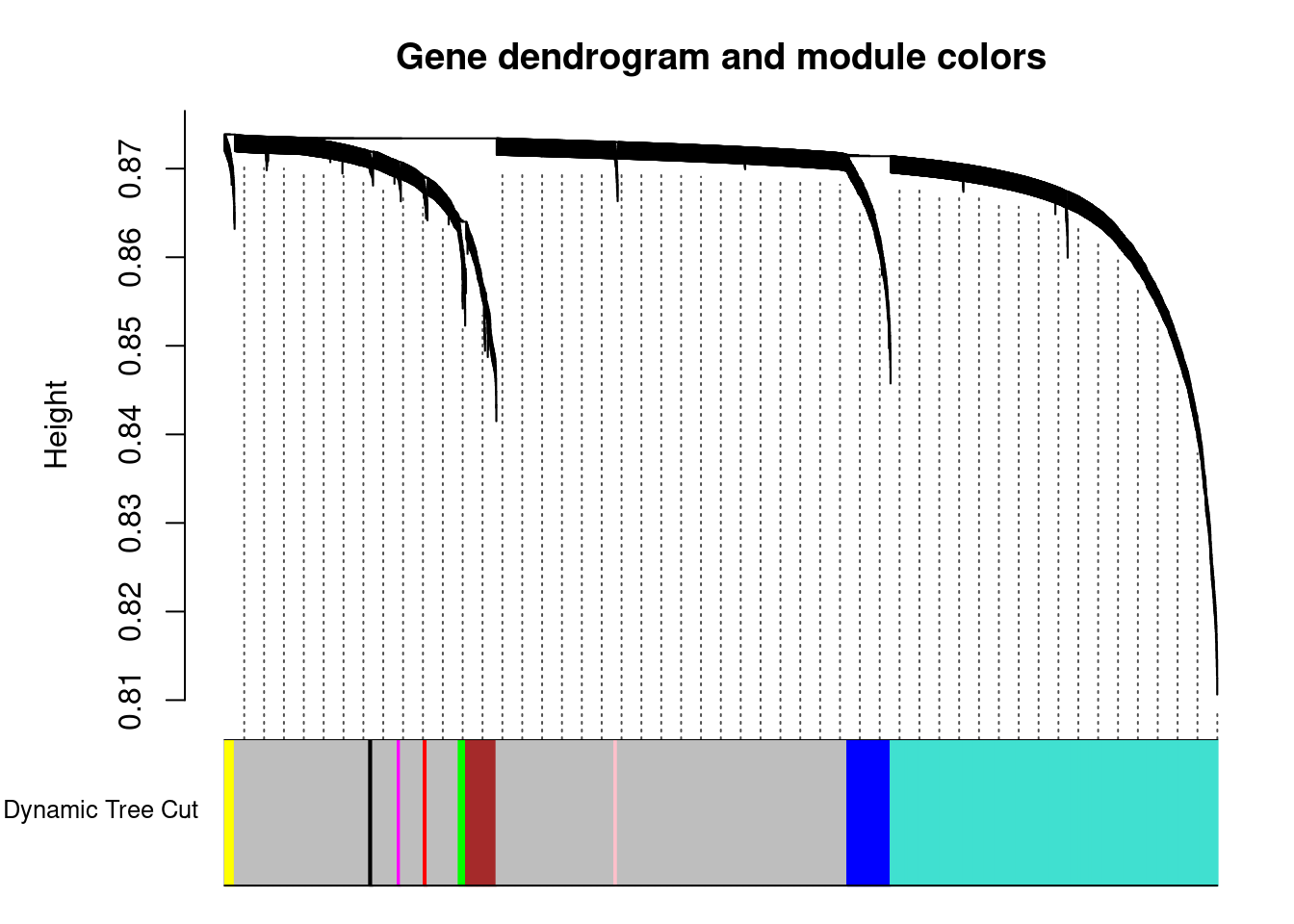
Calculate Eigengenes and Merge Close Modules
MEs = moduleEigengenes(datExpr, dynamicColors)$eigengenes #this matrix gives correlations between cells and module eigengenes (a high value indicates that the cell is highly correlated with the genes in that module)
ME1<-MEs
row.names(ME1)<-row.names(datExpr)
# Calculate dissimilarity of module eigengenes
MEDiss = 1-cor(MEs);
# Cluster module eigengenes
METree = hclust(as.dist(MEDiss), method = "average");
# Plot the result
plot(METree, main = "Clustering of module eigengenes",xlab = "", sub = "")
MEDissThres = 0.2
# Plot the cut line into the dendrogram
abline(h=MEDissThres, col = "red")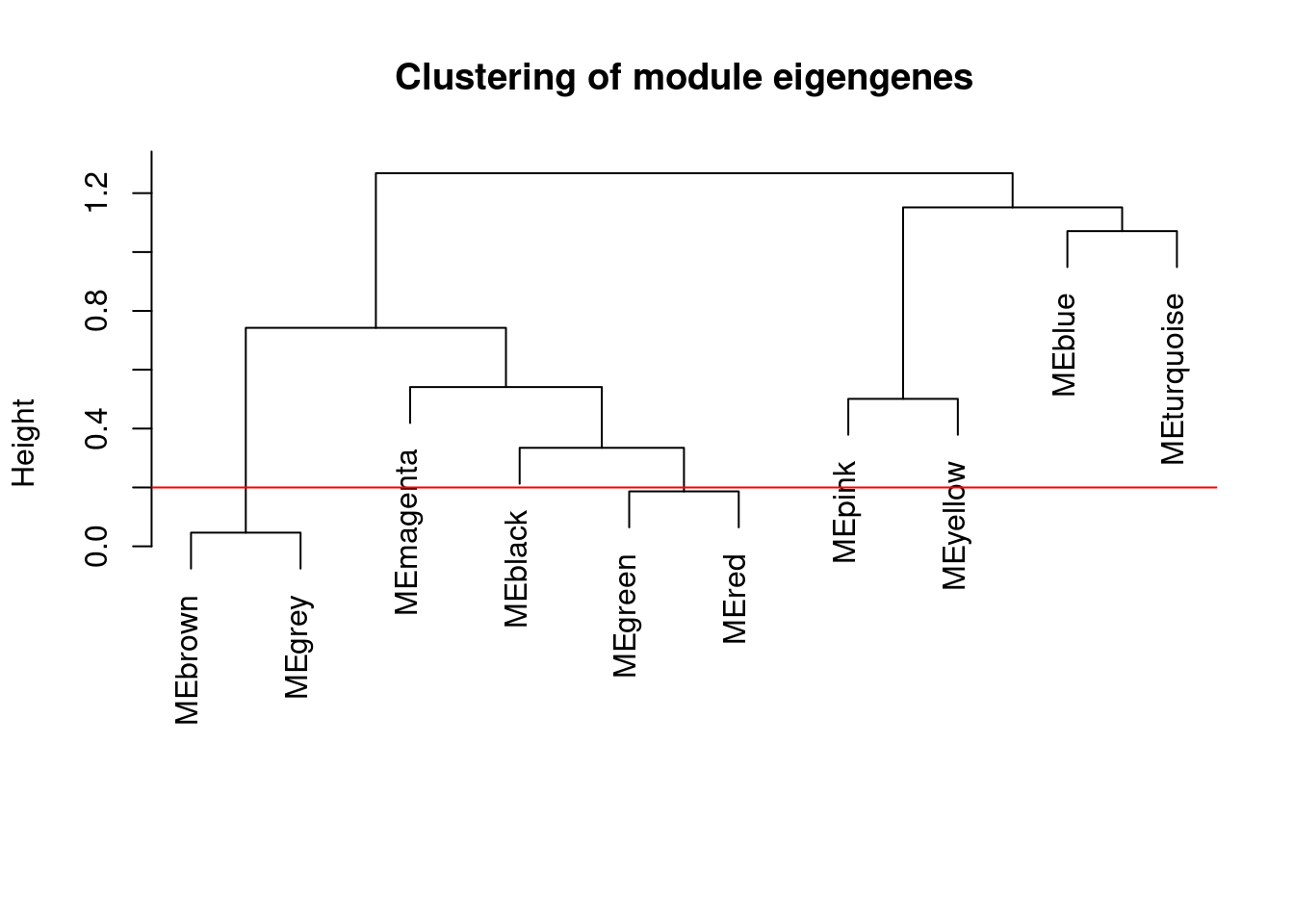
The merged module colors
merge = mergeCloseModules(datExpr, dynamicColors, cutHeight = MEDissThres, verbose = 3) mergeCloseModules: Merging modules whose distance is less than 0.2
multiSetMEs: Calculating module MEs.
Working on set 1 ...
moduleEigengenes: Calculating 10 module eigengenes in given set.
multiSetMEs: Calculating module MEs.
Working on set 1 ...
moduleEigengenes: Calculating 9 module eigengenes in given set.
Calculating new MEs...
multiSetMEs: Calculating module MEs.
Working on set 1 ...
moduleEigengenes: Calculating 9 module eigengenes in given set.mergedColors = merge$colors
mergedMEs = merge$newMEs
moduleColors = mergedColors
MEs = mergedMEs
modulekME = signedKME(datExpr,MEs)Plot merged modules
plotDendroAndColors(geneTree, cbind(dynamicColors, mergedColors),
c("Dynamic Tree Cut", "Merged dynamic"),
dendroLabels = FALSE, hang = 0.03,
addGuide = TRUE, guideHang = 0.05)
# Rename to moduleColors
moduleColors = mergedColors
# Construct numerical labels corresponding to the colors
# colorOrder = c("grey", standardColors(50));
# moduleLabels = match(moduleColors, colorOrder)-1
MEs = mergedMEs
modulekME = signedKME(datExpr,MEs)#type gene name, prints out gene names also in that module
modules<-MEs
c_modules<-data.frame(moduleColors)
row.names(c_modules)<-colnames(datExpr) #assign gene names as row names
module.list.set1<-substring(colnames(modules),3) #removes ME from start of module names
index.set1<-0
Network=list() #create lists of genes for each module
for (i in 1:length(module.list.set1)){index.set1<-which(c_modules==module.list.set1[i])
Network[[i]]<-row.names(c_modules)[index.set1]}
names(Network)<-module.list.set1
lookup<-function(gene,network){return(network[names(network)[grep(gene,network)]])} #load functionFilter metadata table and correlate with eigengenes
nGenes = ncol(datExpr)
nSamples = nrow(datExpr)
MEs = orderMEs(MEs)
ventric$group<-paste0(ventric$trt,"_",ventric$day)
var<-model.matrix(~0+ventric$group)
#colnames(var)<-c("DV","FGF1","FGF19", "V")
moduleTraitCor <- cor(MEs, var, use="p")
moduleTraitPvalue = corPvalueStudent(moduleTraitCor, nSamples)
cor<-melt(moduleTraitCor)
ggplot(cor, aes(Var2, Var1)) + geom_tile(aes(fill = value),
colour = "white") + scale_fill_gradient2(midpoint = 0, low = "blue", mid = "white",
high = "red", space = "Lab", name="Correlation \nStrength") +
theme(axis.text.x = element_text(angle = 45, hjust = 1)) + xlab("Treatment") + ylab(NULL)
Get hubgenes in order
hubgenes<-lapply(seq_len(length(Network)), function(x) {
dat<-modulekME[Network[[x]],]
dat<-dat[order(-dat[paste0("kME",names(Network)[x])]),]
gene<-rownames(dat)
return(gene)
})
names(hubgenes)<-names(Network)
d <- unlist(hubgenes)
d <- data.frame(gene = d,
vec = names(d))
write_csv(d, path=here("output/glia/wgcna/allglia_wgcna_genemodules.csv"))Build linear models for differential expression
MEs %>% select(-MEgrey) -> MEs
data<-data.frame(MEs, day=ventric$day, trt=ventric$trt,
sample=as.factor(ventric$sample), group=ventric$group,
batch=ventric$batch, celltype=Idents(ventric),
groupall=paste0(Idents(ventric), ventric$group))
mod<-lapply(colnames(MEs), function(me) {
mod<-lmer(MEs[[me]] ~ group*celltype + (1|batch) + (1|sample), data=data)
pairwise<-emmeans(mod, pairwise ~ group|celltype)
plot<-data.frame(plot(pairwise, plotIt=F)$data)
sig<-as.data.frame(pairwise$contrasts)
sig%>%separate(contrast, c("start", "end"), sep = " - ") -> sig
yvals<-unlist(lapply(unique(sig$celltype), function(x) {
x<-as.character(x)
y<-data[data$celltype==x,]
z<-max(as.numeric(y[[me]]))
names(z)<-x
return(z)
}))
sig$yvals<-yvals[match(sig$celltype, names(yvals))]
sig$yvals[duplicated(sig$yvals)]<-sig$yvals[duplicated(sig$yvals)]+.004
sig$yvals[duplicated(sig$yvals)]<-sig$yvals[duplicated(sig$yvals)]+.004
sig$yvals[duplicated(sig$yvals)]<-sig$yvals[duplicated(sig$yvals)]+.004
return(sig)
})Warning in checkConv(attr(opt, "derivs"), opt$par, ctrl =
control$checkConv, : Model failed to converge with max|grad| = 0.00359644
(tol = 0.002, component 1)names(mod) <- colnames(MEs)
sig <- bind_rows(mod, .id="id")
sig$symbol <- sig$p.value
sig$symbol[findInterval(sig$symbol, c(0.1,2)) == 1L] <-NA
sig$symbol[findInterval(sig$symbol, c(0.01,0.1)) == 1L] <- "*"
sig$symbol[findInterval(sig$symbol, c(0.001,0.01)) == 1L] <- "**"Warning in findInterval(sig$symbol, c(0.001, 0.01)): NAs introduced by
coercionsig$symbol[findInterval(sig$symbol, c(1e-200,0.001)) == 1L] <- "***" Warning in findInterval(sig$symbol, c(1e-200, 0.001)): NAs introduced by
coerciondata <- melt(data, id.vars = c("day","trt","sample","group","batch","celltype","groupall"))
lapply(unique(data$variable), function(x) {
tryCatch({
print(ggplot(data=data[data$variable==x,], aes(x=group, y=as.numeric(value))) +
geom_quasirandom(aes(fill=sample), shape=21, size=2, alpha=.75) +
scale_fill_manual(values=pal_jco()(10)) + ylab(NULL) + xlab(NULL) +
theme_pubr() + theme(axis.text.x = element_text(angle=45, hjust=1, face="bold"), plot.title = element_text(hjust=0.5)) +
scale_y_continuous(aes(name="",limits=c(min(value)-.02,max(value))+.02)) + facet_wrap(.~celltype) +
labs(y=NULL, x=NULL) + ggtitle(x)) },
error = function(err) {
print(err)
}
)
})


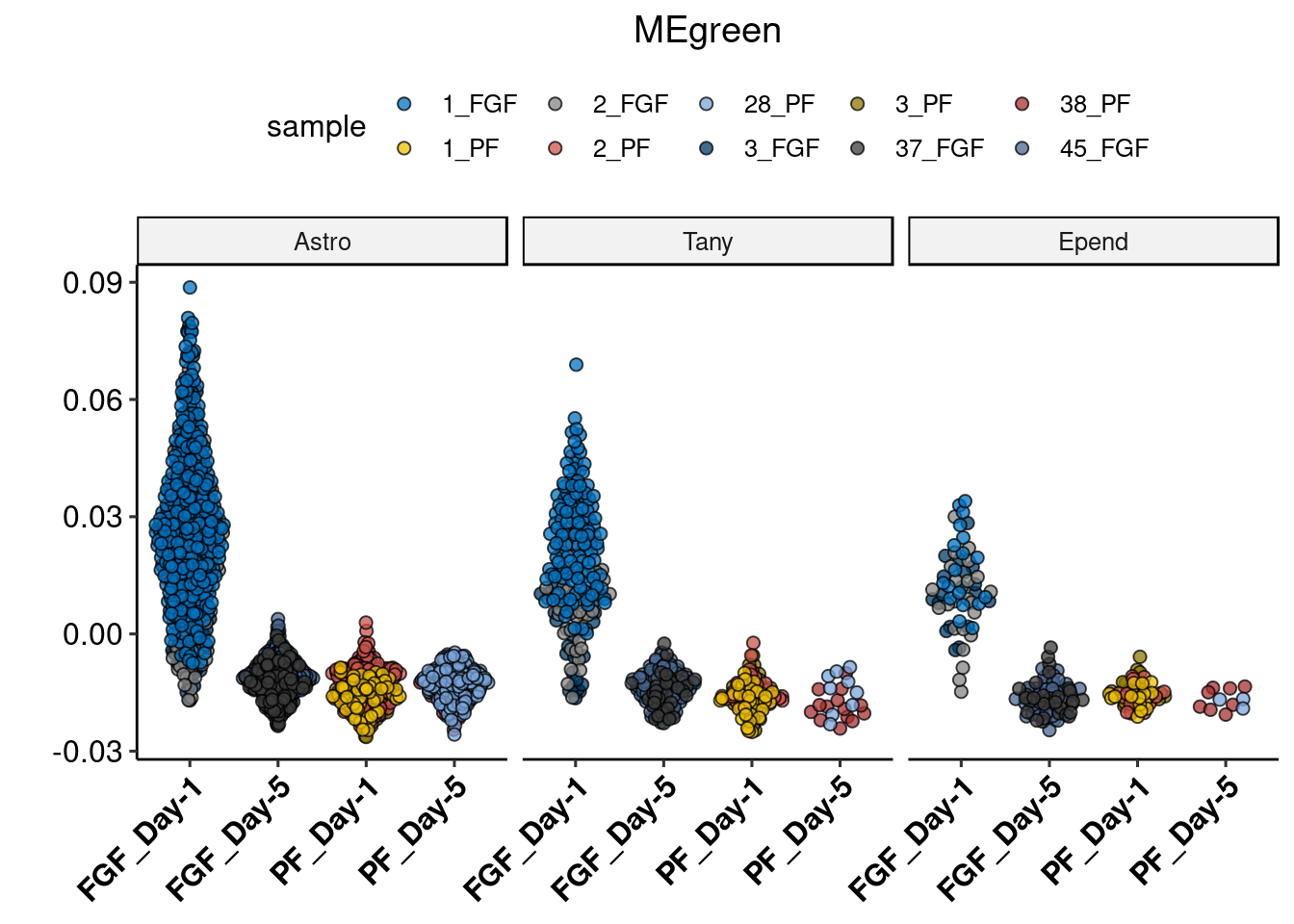
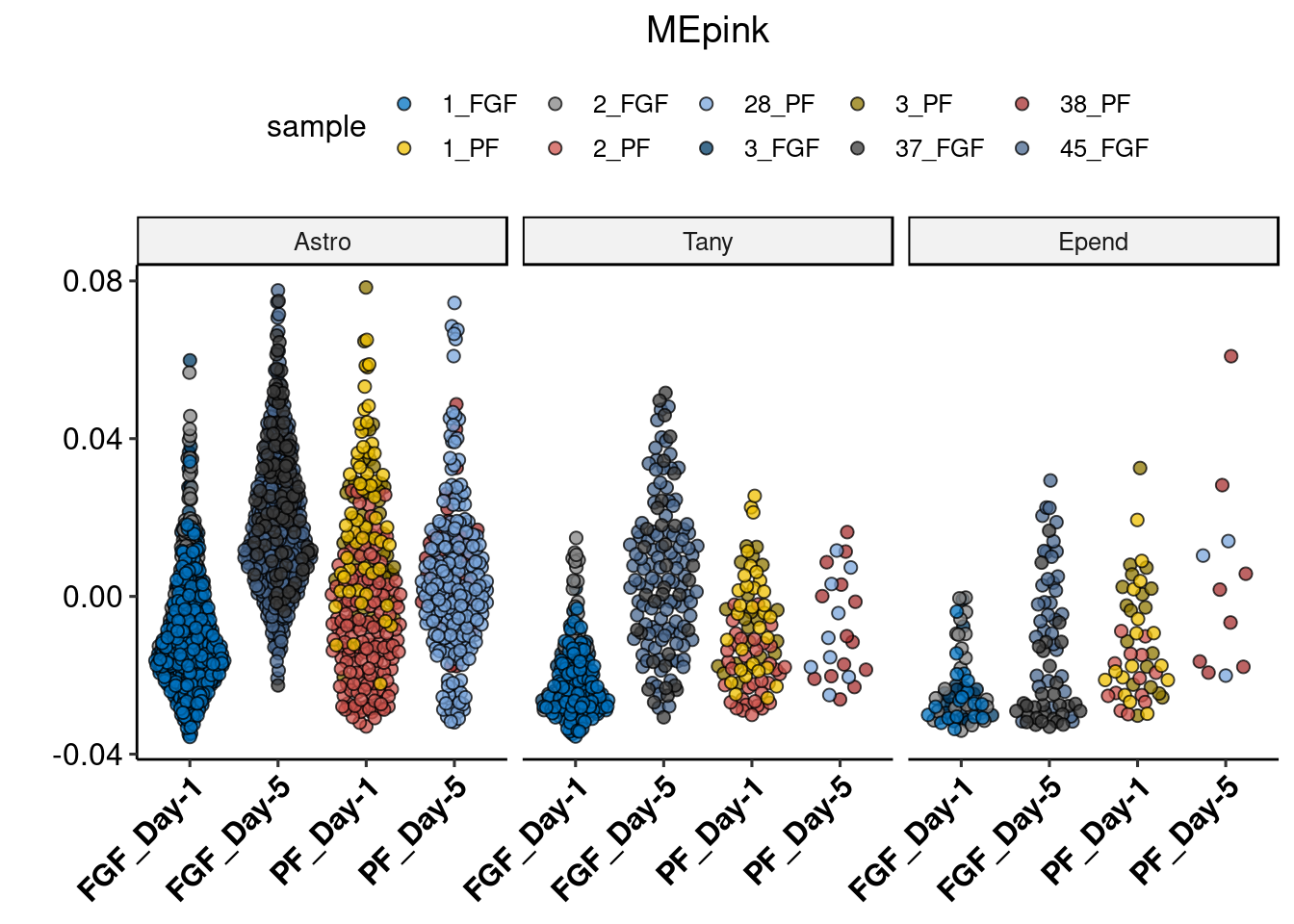
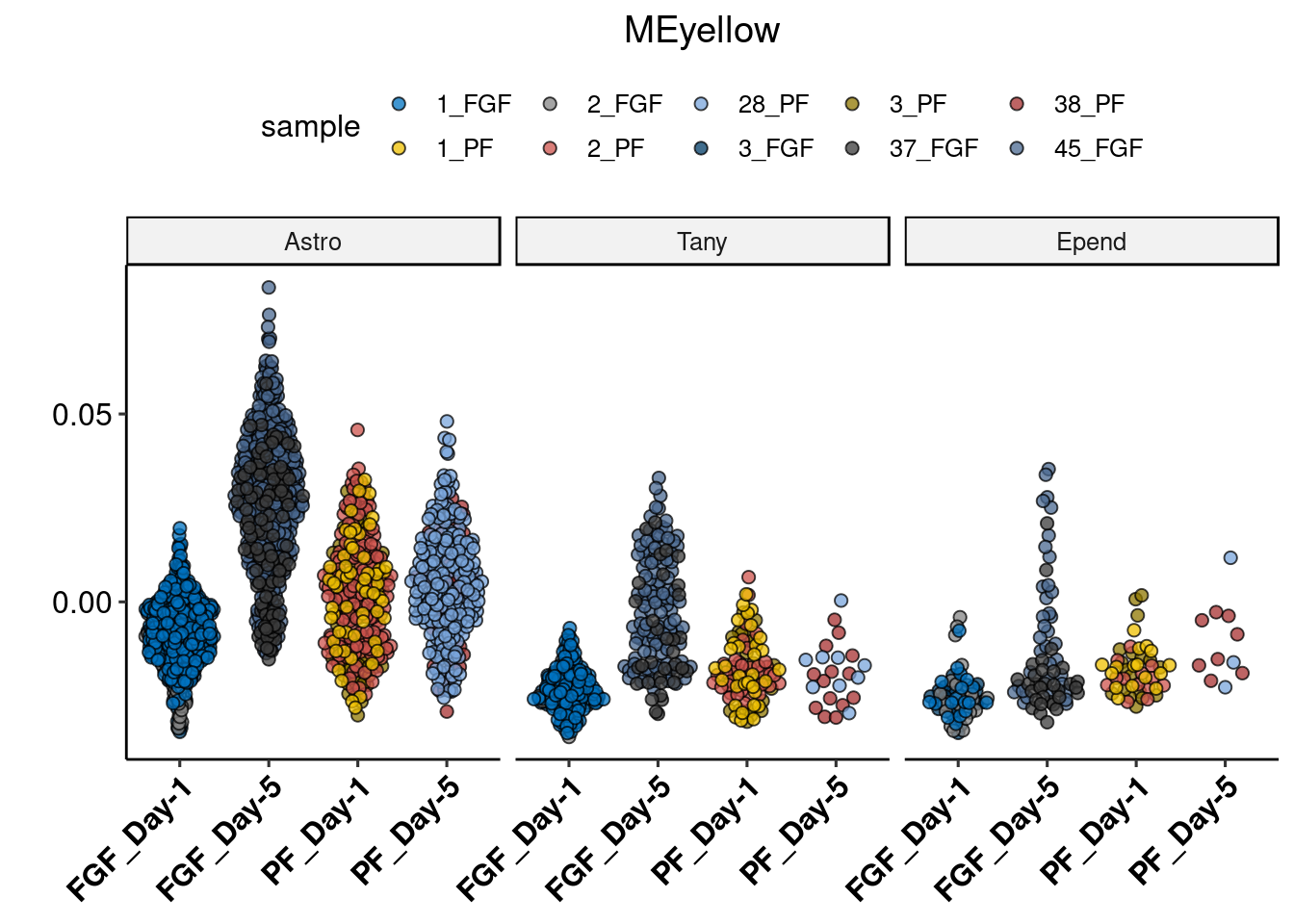
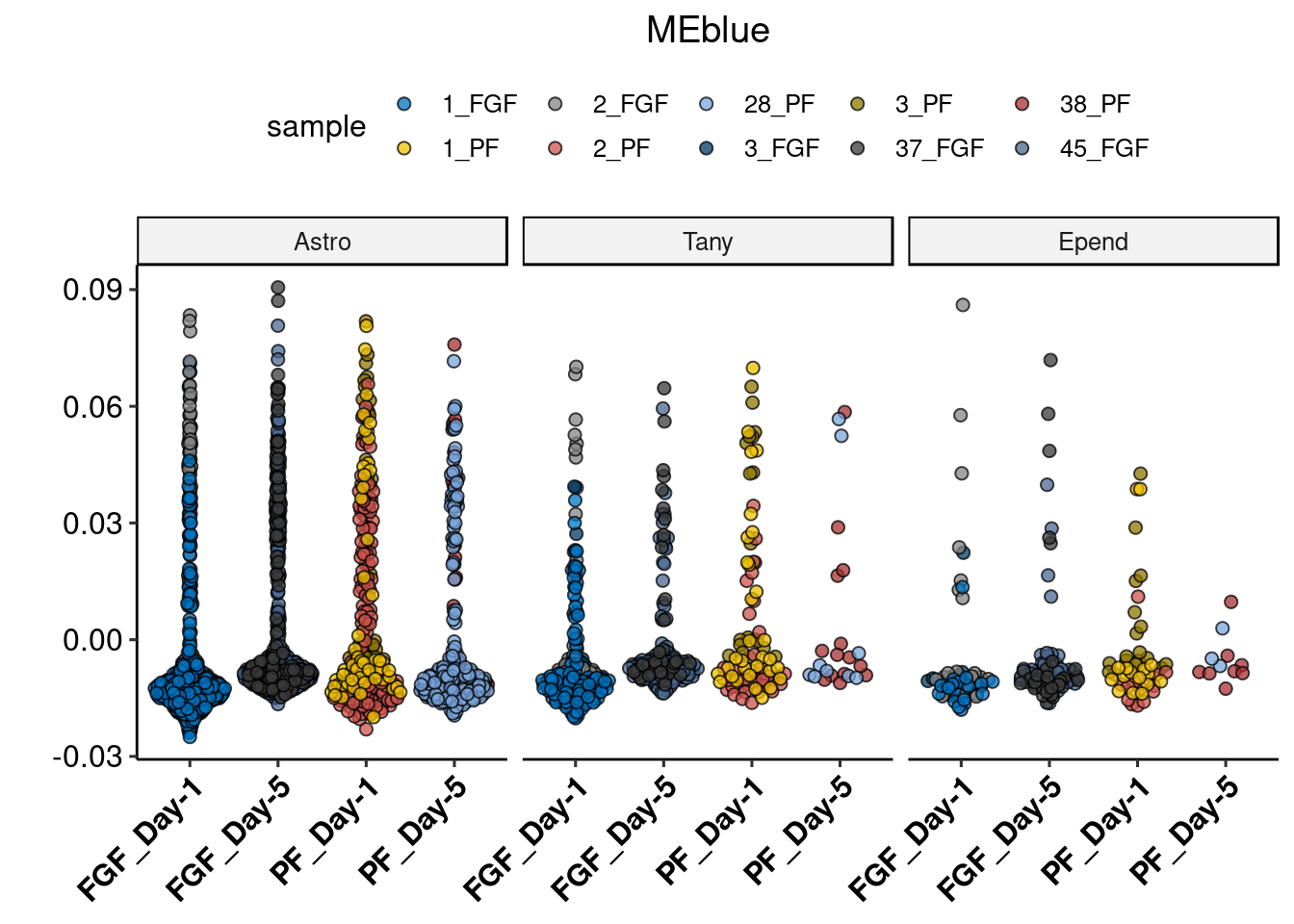
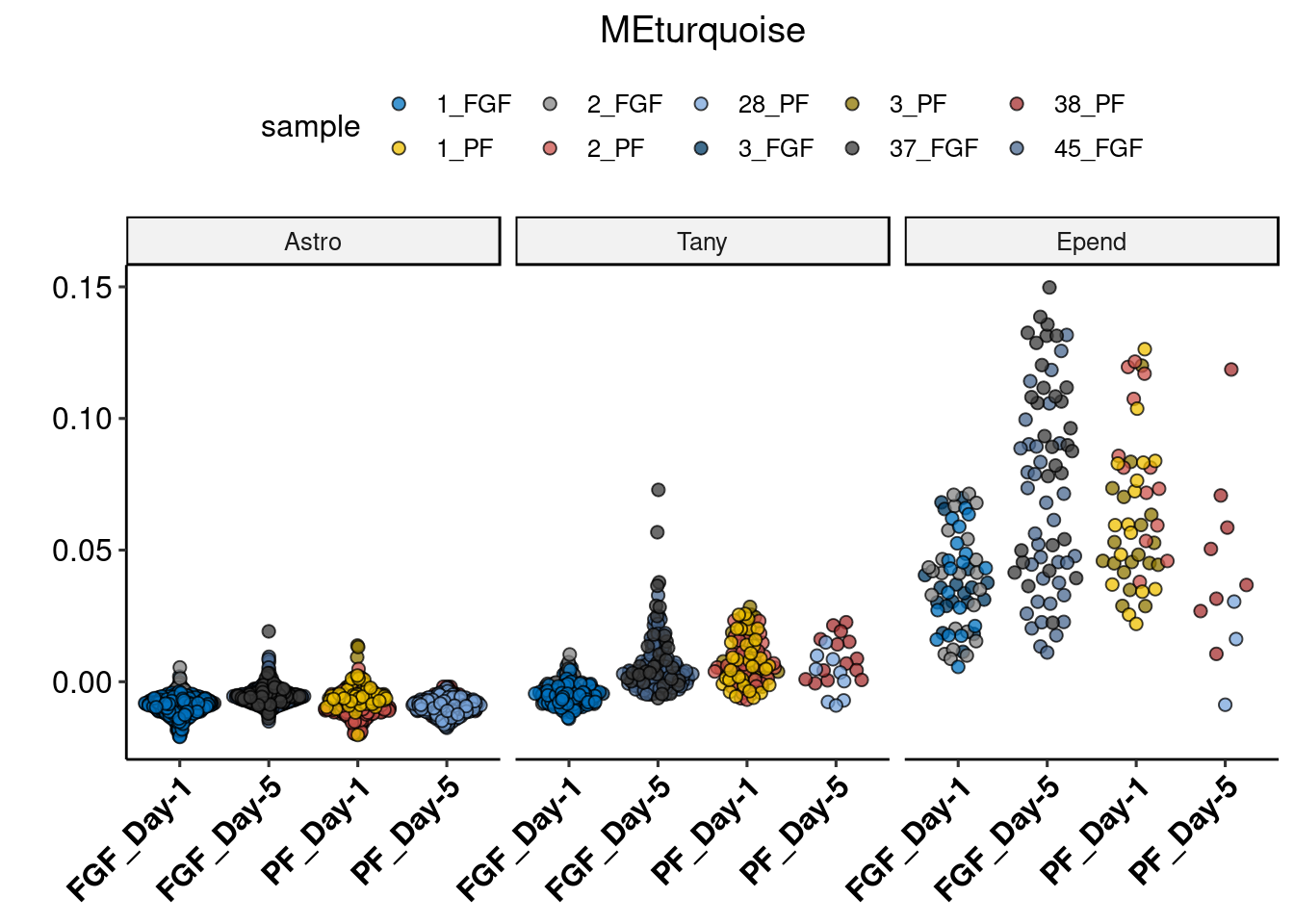
[[1]]
[[2]]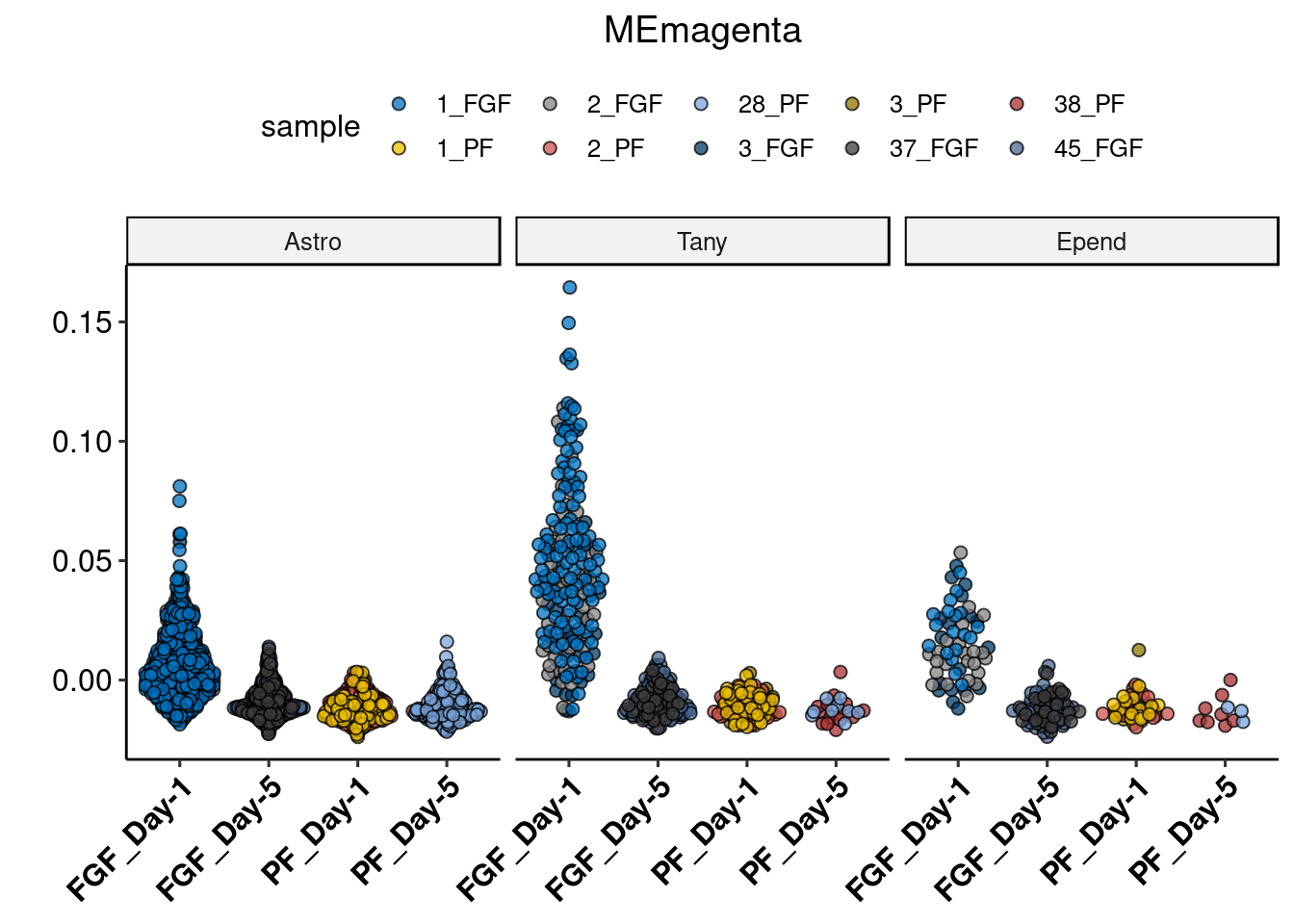
[[3]]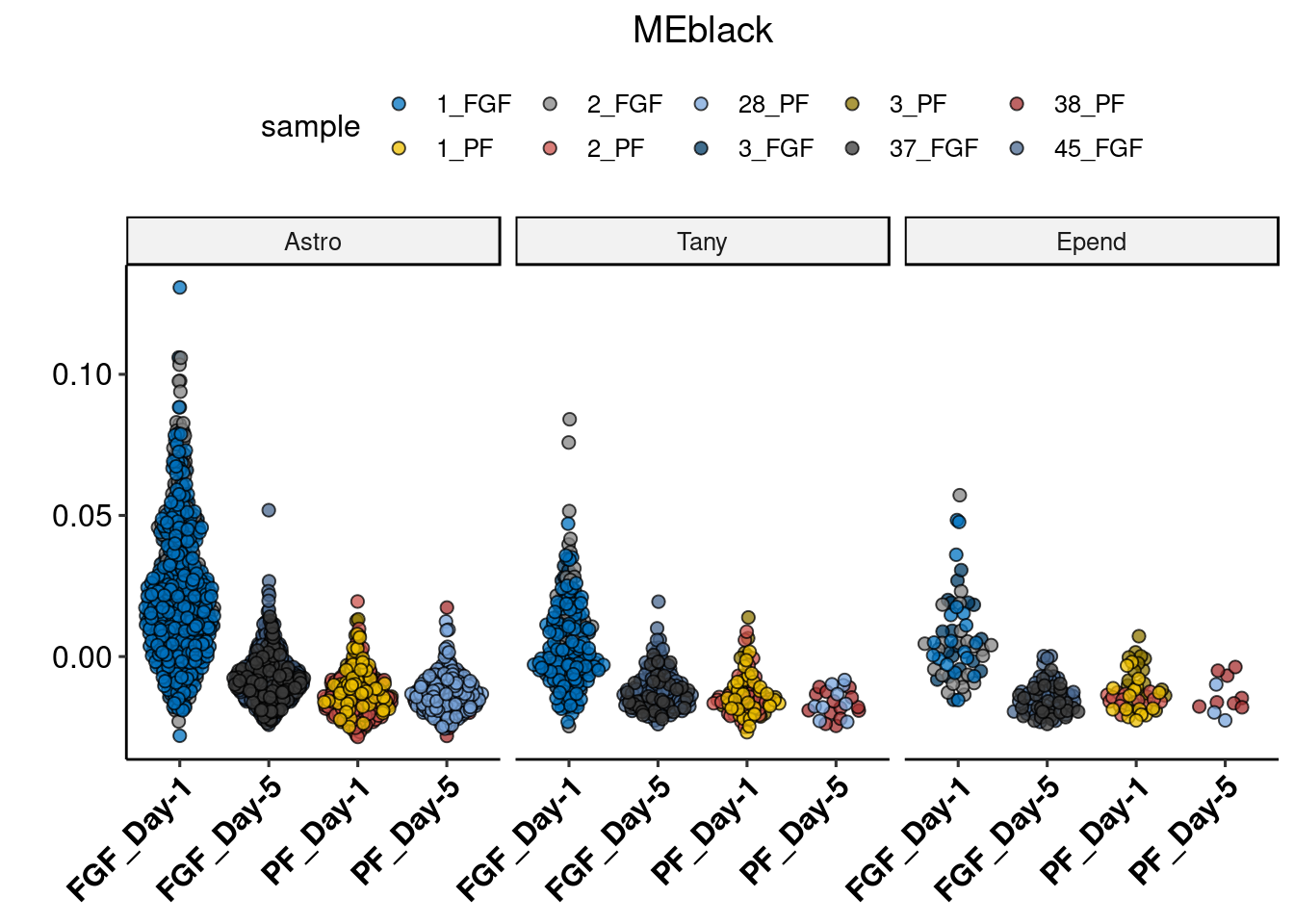
[[4]]
[[5]]
[[6]]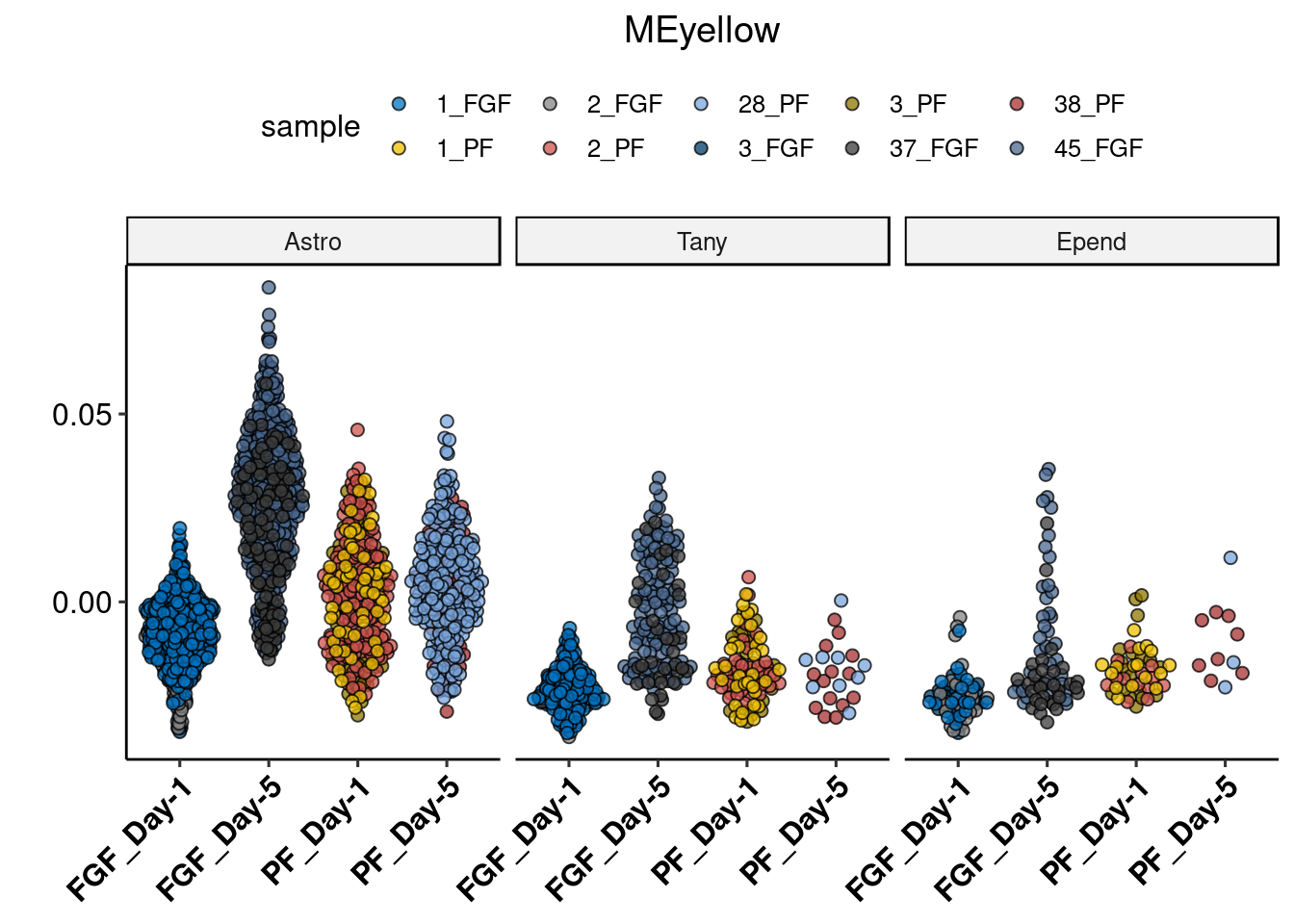
[[7]]
[[8]]
# moddat <- bind_rows(mod, .id="id")
write_csv(sig, path=here("output/glia/wgcna/allglia_wgcna_linearmodel_testing.csv"))sig %>%
unite(start, end, col = "comparison", remove = F) %>%
filter(comparison == "FGF_Day-1_PF_Day-1" | comparison == "FGF_Day-5_PF_Day-5") %>%
unite(estimate, p.value, sep = ",", col = "value") %>%
dcast(id + celltype ~ start, value.var = "value") %>%
separate(`FGF_Day-1`, into = c("estimate_1", "p.value_1"), sep = ",") %>%
separate(`FGF_Day-5`, into = c("estimate_5", "p.value_5"), sep = ",") %>%
mutate(id = gsub(id, pattern = "ME", replacement = "")) %>%
mutate(col = if_else(as.numeric(p.value_1) < 0.1 | as.numeric(p.value_5) < 0.1, true = id, false = "grey")) %>%
mutate(sig = if_else(as.numeric(p.value_1) < 0.1 & as.numeric(p.value_5) < 0.1, true = "red",
false = if_else(as.numeric(p.value_1) < 0.1, true = "blue",
false = if_else(as.numeric(p.value_5) < 0.1, true = "black", false = "")
)
)) %>%
mutate(label = if_else(sig == "blue", true = "DE at Day 1", false = "")) -> plot
cols <- unique(plot$col)
names(cols) <- cols
ggplot(plot, aes(x = as.numeric(estimate_1), y = as.numeric(estimate_5))) +
geom_point(data = filter(plot, sig != ""), aes(shape = celltype), size = 4) +
scale_shape(name="Cell-Type") +
geom_mark_ellipse(data = plot %>% filter(sig == "blue", p.value_1 != 0.0230780280327769), color = "black", linetype = "dashed") +
geom_point(size = 4, aes(color = col, shape = celltype)) + coord_flip() + geom_hline(yintercept = 0) +
scale_color_manual(values = cols, name = "Modules") +
geom_vline(xintercept = 0) +
annotate(
geom = "curve", x = 0.045, y = 0.02, xend = 0.03, yend = 0.005,
curvature = .3, arrow = arrow(length = unit(2, "mm"))
) + annotate(geom = "label", x = 0.045, y = 0.022, label = "DE only at Day 1", hjust = "left") +
annotate(
geom = "curve", x = -0.01, y = 0.03, xend = -0.025, yend = 0.035,
curvature = .3, arrow = arrow(length = unit(2, "mm"))
) + annotate(geom = "label", x = -0.005, y = 0.0275, label = "DE at both", hjust = "left") +
annotate(
geom = "curve", x = 0.01, y = 0.015, xend = -0.011, yend = 0.02,
curvature = .3, arrow = arrow(length = unit(2, "mm"))
) + annotate(geom = "label", x = 0.015, y = 0.01, label = "DE only at Day 5", hjust = "left") + theme_bw() + xlab("Day 1 Estimate") +
ylab("Day 5 Estimate") + labs_pubr()
ggsave(here("output/wgcna_res.png"), w=8, h=5)Find GO term enrichment of modules
names(mod)<-colnames(MEs)[grepl("^ME", colnames(MEs))]
go_col <- unique(plot$col)[-grep("grey", unique(plot$col))]
goterms<-lapply(go_col, function(x) {
x<-gprofiler(hubgenes[[x]], ordered_query = T,
organism = "mmusculus", significant = T, custom_bg = colnames(datExpr),
src_filter = c("GO:BP","REAC","KEGG"), hier_filtering = "strong",
min_isect_size = 3,
sort_by_structure = T,exclude_iea = T,
min_set_size = 10, max_set_size = 300,correction_method = "fdr")
x<-x[order(x$p.value),]
return(x)
})
names(goterms) <- go_col
goterms %>% bind_rows(.id="id") %>%
mutate(padj=p.adjust(p.value, "fdr")) -> godat
write_csv(godat, path=here("output/glia/wgcna/allglia_wgcna_goterms.csv"))
godat %>% group_by(id) %>% filter(id %in% c("black","green")) %>% arrange(p.value) %>% slice(1:5) %>%
select(p.value, padj, term.name, domain, id) %>% arrange(id) %>%
ggplot(aes(x=str_wrap(term.name,20), y=-log10(padj), fill=domain)) + geom_col() +
scale_fill_npg() +
facet_wrap(.~id, scales="free_y", ncol=1) + theme_pubr() +
theme(text = element_text(size=7),
axis.text.x = element_text(angle=45, hjust=1)) + coord_flip() +
xlab("GO Term") + geom_hline(yintercept = -log10(0.05), linetype="dashed", size=1) +
labs_pubr()
ggsave(filename = here("output/glia/wgcna/allglia_goterm.png"), h=6, w=8)
sessionInfo()R version 3.5.3 (2019-03-11)
Platform: x86_64-pc-linux-gnu (64-bit)
Running under: Storage
Matrix products: default
BLAS/LAPACK: /usr/lib64/libopenblas-r0.3.3.so
locale:
[1] LC_CTYPE=en_DK.UTF-8 LC_NUMERIC=C
[3] LC_TIME=en_DK.UTF-8 LC_COLLATE=en_DK.UTF-8
[5] LC_MONETARY=en_DK.UTF-8 LC_MESSAGES=en_DK.UTF-8
[7] LC_PAPER=en_DK.UTF-8 LC_NAME=C
[9] LC_ADDRESS=C LC_TELEPHONE=C
[11] LC_MEASUREMENT=en_DK.UTF-8 LC_IDENTIFICATION=C
attached base packages:
[1] stats graphics grDevices utils datasets methods base
other attached packages:
[1] ggforce_0.3.0.9000 here_0.1 ggpubr_0.2.1
[4] magrittr_1.5 gProfileR_0.6.7 igraph_1.2.4.1
[7] reshape2_1.4.3 forcats_0.4.0 stringr_1.4.0
[10] dplyr_0.8.3 purrr_0.3.2 readr_1.3.1.9000
[13] tidyr_0.8.3 tibble_2.1.3 tidyverse_1.2.1
[16] genefilter_1.64.0 ggbeeswarm_0.6.0 ggplot2_3.2.1
[19] lme4_1.1-21 Matrix_1.2-17 emmeans_1.3.5.1
[22] ggsci_2.9 parallelDist_0.2.4 cluster_2.1.0
[25] WGCNA_1.68 fastcluster_1.1.25 dynamicTreeCut_1.63-1
[28] Seurat_3.0.3.9036
loaded via a namespace (and not attached):
[1] reticulate_1.13 R.utils_2.9.0 tidyselect_0.2.5
[4] robust_0.4-18.1 RSQLite_2.1.1 AnnotationDbi_1.44.0
[7] htmlwidgets_1.3 grid_3.5.3 Rtsne_0.15
[10] munsell_0.5.0 codetools_0.2-16 ica_1.0-2
[13] preprocessCore_1.44.0 future_1.14.0 withr_2.1.2
[16] colorspace_1.4-1 Biobase_2.42.0 highr_0.8
[19] knitr_1.23 rstudioapi_0.10 stats4_3.5.3
[22] ROCR_1.0-7 robustbase_0.93-5 ggsignif_0.5.0
[25] gbRd_0.4-11 listenv_0.7.0 labeling_0.3
[28] Rdpack_0.11-0 git2r_0.25.2 polyclip_1.10-0
[31] farver_1.1.0 bit64_0.9-7 rprojroot_1.3-2
[34] vctrs_0.2.0 coda_0.19-3 generics_0.0.2
[37] TH.data_1.0-10 xfun_0.8 R6_2.4.0
[40] doParallel_1.0.14 rsvd_1.0.2 bitops_1.0-6
[43] assertthat_0.2.1 SDMTools_1.1-221.1 scales_1.0.0
[46] multcomp_1.4-10 nnet_7.3-12 beeswarm_0.2.3
[49] gtable_0.3.0 npsurv_0.4-0 globals_0.12.4
[52] sandwich_2.5-1 workflowr_1.4.0 rlang_0.4.0
[55] zeallot_0.1.0 splines_3.5.3 lazyeval_0.2.2
[58] acepack_1.4.1 impute_1.56.0 broom_0.5.2
[61] checkmate_1.9.4 modelr_0.1.4 yaml_2.2.0
[64] backports_1.1.4 Hmisc_4.2-0 tools_3.5.3
[67] gplots_3.0.1.1 RColorBrewer_1.1-2 BiocGenerics_0.28.0
[70] ggridges_0.5.1 Rcpp_1.0.2 plyr_1.8.4
[73] base64enc_0.1-3 RCurl_1.95-4.12 rpart_4.1-15
[76] pbapply_1.4-1 cowplot_1.0.0 S4Vectors_0.20.1
[79] zoo_1.8-6 haven_2.1.0 ggrepel_0.8.1
[82] fs_1.3.1 data.table_1.12.2 lmtest_0.9-37
[85] RANN_2.6.1 mvtnorm_1.0-11 fitdistrplus_1.0-14
[88] matrixStats_0.54.0 hms_0.5.0 lsei_1.2-0
[91] evaluate_0.14 xtable_1.8-4 pbkrtest_0.4-7
[94] XML_3.98-1.20 readxl_1.3.1 IRanges_2.16.0
[97] gridExtra_2.3 compiler_3.5.3 KernSmooth_2.23-15
[100] crayon_1.3.4 minqa_1.2.4 R.oo_1.22.0
[103] htmltools_0.3.6 pcaPP_1.9-73 Formula_1.2-3
[106] rrcov_1.4-7 RcppParallel_4.4.3 lubridate_1.7.4
[109] DBI_1.0.0 tweenr_1.0.1 MASS_7.3-51.4
[112] boot_1.3-22 cli_1.1.0 R.methodsS3_1.7.1
[115] gdata_2.18.0 parallel_3.5.3 metap_1.1
[118] pkgconfig_2.0.2 fit.models_0.5-14 foreign_0.8-71
[121] plotly_4.9.0 xml2_1.2.0 foreach_1.4.4
[124] annotate_1.60.1 vipor_0.4.5 estimability_1.3
[127] rvest_0.3.4 bibtex_0.4.2 digest_0.6.20
[130] sctransform_0.2.0 RcppAnnoy_0.0.12 tsne_0.1-3
[133] cellranger_1.1.0 rmarkdown_1.13 leiden_0.3.1
[136] htmlTable_1.13.1 uwot_0.1.3 gtools_3.8.1
[139] nloptr_1.2.1 nlme_3.1-140 jsonlite_1.6
[142] viridisLite_0.3.0 pillar_1.4.2 lattice_0.20-38
[145] httr_1.4.1 DEoptimR_1.0-8 survival_2.44-1.1
[148] GO.db_3.7.0 glue_1.3.1 png_0.1-7
[151] iterators_1.0.10 bit_1.1-14 stringi_1.4.3
[154] blob_1.1.1 latticeExtra_0.6-28 caTools_1.17.1.2
[157] memoise_1.1.0 irlba_2.3.3 future.apply_1.3.0
[160] ape_5.3